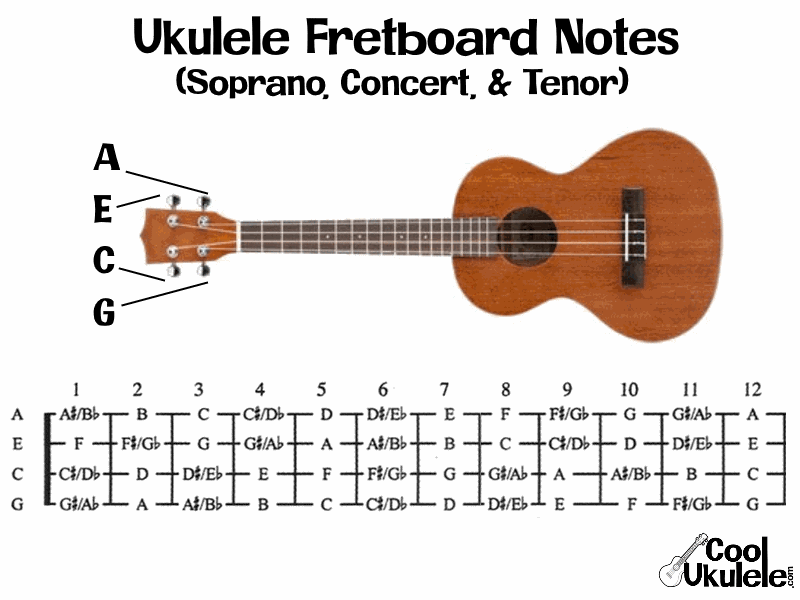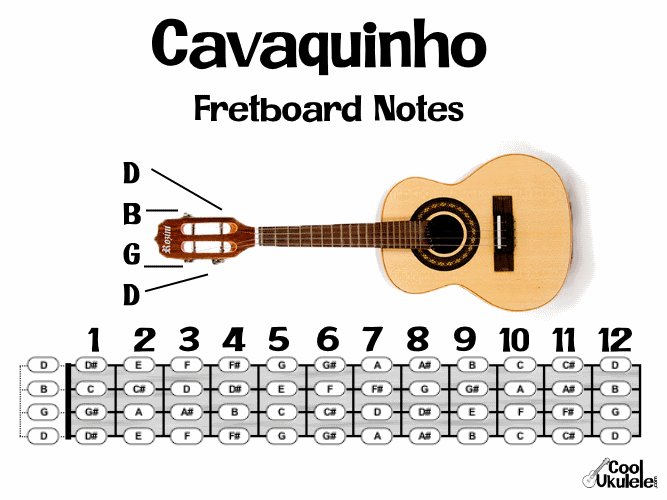The Portuguese cavaquinho is small 4-stringed instrument in the guitar family. A version of the cavaquinho, the machete, is considered the direct precursor to the modern Ukulele.
(As a side note, the braguinha, another version of the cavaquinho, is considered the precursor to the machete.)

Are you trying to decide between buying a Cavaquinho or a Ukulele? Or maybe just curious about the differences between these two 4-stringed instrument relatives?
Either way, you’ve come to the right place.
Contents
- What are the Main Differences Between the Cavaquinho and the Ukulele?
- The Shared History of the Cavaquinho and the Ukulele
- Tuning, Playing, and Sound Comparison Between the Cavaquinho and the Ukulele
- Physical & Construction Differences Between the Cavaquinho and the Uke
- Availability of the Cavaquinho vs. the Ukulele
- Cavaquinho vs. Ukulele: The Conclusion
- Frequently Asked Questions about the Cavaquinho and Ukulele
- Which Instrument Do You Prefer, Cavaquinho or Ukulele?
What are the Main Differences Between the Cavaquinho and the Ukulele?
The main differences between the Cavaquinho and the Ukulele are their tuning systems and string materials. The Cavaquinho is traditionally tuned to DGBD with linear tuning, while the Ukulele’s standard tuning is GCEA with a high (re-entrant) G string. The Cavaquinho uses steel strings which produce a sharper, crisper sound, while the ukulele’s nylon strings produce a softer, more mellow sound.
The Shared History of the Cavaquinho and the Ukulele
The name Cavaquinho means “little wood splinter” in Portuguese. It came about as a smaller member of the lute and guitar family in Portugal.
When the Portuguese arrived in Hawaii, they brought this easily-portable stringed instrument with them for entertainment. According to legend, the native Hawaiians, seeing how fast the players’ fingers and hands moved while playing, called the instrument the “ukulele”, which means “jumping flea” in Hawaiian.
In Hawaii, a version of the Cavaquinho, the machete, underwent small changes and eventually became what we know as the modern ukulele in the 1800’s.
Here’s a video which discusses some of this History as well as some comparison points between the two instruments:
Tuning, Playing, and Sound Comparison Between the Cavaquinho and the Ukulele
What are the Tuning Differences between the Cavaquinho and the Ukulele?
The standard tuning system for soprano, concert, and tenor ukuleles is GCEA with a high (re-entrant) G string. The C is middle C and the G, E, and A are those notes just above middle C.

The Cavaquinho is most commonly tuned with a DGBD setup, with the first D, G, and B being those notes just above middle C, and the last D being an octave above the first D. This tuning is linear, meaning from lowest to highest, as opposed to the ukulele’s traditionally re-entrant tuning.
Both Instruments also have many alternative tuning systems.
For the Ukulele, this includes baritone tuning (DGBE linear), low-G Tuning (GCEA linear) and D tuning (ADF#B re-entrant tuning one step higher than standard).
For Cavaquinho, this includes CGAD tuning (popular in Portugal), DGBE (for soloing), GDAE (mandolin tuning), and many others.
Are the Ukulele and Cavaquinho played similarly?
In my opinion, Yes. Both instruments seem to generally be played with a very “strum-focused” technique.
The Cavaquinho might be played with slight more emphasis on complex strumming patterns compared to the generally simple strums of the typical ukulele player, but complex strumming is also pretty common on ukulele.
Sound Differences Between The Ukulele and the Cavaquinho
Both instruments share the same light, bright, and whimsical tone due to their relatively similar sizes and high tunings.
Though the Cavanquinho might be slightly lighter. brighter, and more whimsical due to its standard tuning (DGBD) being one step higher than the ukulele’s standard tuning (GCEA).
The main noticeable sound difference is that the ukulele has a hollower, flatter, more mellow sound, due to its softer nylon strings. While the Cavaquinho has a sharper, crisper sound due to its steel strings.
Fretboard Comparison Between the Cavaquinho and the Ukulele
Here’s an image showing the fretboard notes of the Ukulele with standard GCEA tuning:

And here’s one showing the fretboard notes for the Cavaquinho with DBGD tuning:

Physical & Construction Differences Between the Cavaquinho and the Uke
What’s The Difference Between Ukulele and Cavaquinho Strings?
Ukuleles traditionally use gut or nylon strings.
The Cavaquinho, on the other hand, uses steel strings.
As mentioned above, this gives the uke a more mellow, flat sound as compared to the Cavaquinho with its sharper, crisper sounding steel strings.
The Construction of the Cavaquinho vs. the Ukulele
The Cavaquino generally has a thinner body compared to the ukulele.
It also traditionally has a fret-board which is flush with the top panel of the body, whereas the ukulele’s fret-board usually sticks out from the body of the instrument.
Head-Stock and Tuning Mechanism Comparison of the Cavaquinho and the Ukulele
The Cavaquinho traditionally has a cut-out head-stock with laterally installed friction tuners.
The Ukulele, on the other hand, traditionally has front-to-back installed friction tuners without a cut-out head-stock. However, on modern ukuleles, geared tuners are probably more common, and cut-out head-stocks ,though rare, are available.
Availability of the Cavaquinho vs. the Ukulele
The Ukulele is much more readily available than the Cavaquinho. Especially in English-speaking countries and on English websites. This means there is a much wider selection of Ukuleles and accessories to choose from compare to the Cavaquinho.
Because of this wider availability, you can be more selective in your choosing of an instrument and find more of a range of quality, options, and materials with Ukuleles.
Cavaquinho vs. Ukulele: The Conclusion
Well, there you have it.
These two relatives, though very similar, do have their differences.
The ukulele is tuned differently, uses different string materials, has some small differences in construction, and has a generally different sound due to these differences, compared with the Cavaquinho.
Thanks for reading and be sure to leave a comment if we missed anything!
Happy Strumming!
Frequently Asked Questions about the Cavaquinho and Ukulele
Cavaquinho vs. Ukulele: Basic Information
- What is a cavaquinho?
- The cavaquinho is a small, four-stringed musical instrument originating from Portugal and commonly used in Brazilian music.
- What is a ukulele?
- The ukulele is a small, four-stringed musical instrument that originated in Hawaii and is popular for its bright and tropical sound.
- What are the main differences in origin and cultural significance between the cavaquinho and the ukulele?
- The cavaquinho is rooted in Portuguese and Brazilian music traditions, while the ukulele has its origins in Hawaiian music. Both have since gained popularity worldwide.
Physical Differences
- What is the size difference between a cavaquinho and a ukulele?
- Cavaquinhos are typically smaller than ukuleles, with a shorter scale length and a slightly different body shape.
- What are the common materials used to make cavaquinhos and ukuleles?
- Both instruments can be made from various tonewoods, but cavaquinhos often use traditional woods like rosewood or mahogany, while ukuleles may use koa, mahogany, or spruce.
- Do cavaquinhos and ukuleles have the same number of strings?
- Yes, both cavaquinhos and ukuleles typically have four strings, although variations with more strings exist for both.
- Are there different sizes and shapes of cavaquinhos and ukuleles?
- Yes, there are various sizes and shapes for both instruments. Common ukulele sizes include soprano, concert, tenor, and baritone, while cavaquinhos vary in size depending on the region.
Tuning and Sound
- How are cavaquinho and ukulele strings tuned?
- Cavaquinho strings are typically tuned to D-G-B-D, while ukulele strings are usually tuned to G-C-E-A. However, both instruments can have alternative tunings.
- How does the tuning affect the sound of each instrument?
- The different tunings give each instrument a distinct sound. Cavaquinhos tend to have a brighter and more percussive tone, while ukuleles have a sweeter and mellower sound.
- Can cavaquinho and ukulele players easily switch between the two instruments due to their similar tunings?
- While the tunings are similar, the playing techniques and styles for each instrument can be quite different, making it a challenge to switch seamlessly.
Playing Techniques and Styles
- What are the common playing techniques for the cavaquinho?
- Cavaquinho players often use fingerpicking and strumming techniques, playing a wide range of Brazilian music styles such as samba, choro, and bossa nova.
- What are the common playing techniques for the ukulele?
- Ukulele players commonly use strumming and fingerpicking techniques, and the instrument is versatile, allowing players to perform various musical genres, including folk, pop, and Hawaiian music.
- Are there any notable differences in playing techniques between the cavaquinho and the ukulele?
- Cavaquinho players may employ more complex rhythmic patterns and ornamentations, while ukulele players often focus on melody and harmony.
Popular Music Styles
- In which musical genres is the cavaquinho prominently featured?
- The cavaquinho is a staple instrument in Brazilian music genres such as samba, choro, pagode, and bossa nova.
- In which musical genres is the ukulele commonly used?
- The ukulele is versatile and is used in a wide range of genres, including Hawaiian, folk, pop, rock, and indie music.
Cultural Significance
- What is the cultural significance of the cavaquinho in Brazil?
- The cavaquinho holds a significant place in Brazilian culture, particularly in Rio de Janeiro, where it is closely associated with samba and other traditional music styles.
- What is the cultural significance of the ukulele in Hawaii?
- The ukulele is an iconic instrument in Hawaiian culture, representing the islands’ music and cultural heritage.
Portability and Travel
- Which instrument is more portable, the cavaquinho or the ukulele?
- The ukulele is often considered more portable due to its smaller size and lighter weight.
- Are there travel-sized versions of both the cavaquinho and the ukulele available?
- Yes, both instruments have travel-sized versions that are even more compact and designed for easy transportation.
Popularity Worldwide
- Which instrument, the cavaquinho or the ukulele, has a broader international following?
- The ukulele has a more widespread international presence and is played and loved by musicians and enthusiasts all over the world.
Learning Curve for Beginners
- Which instrument, the cavaquinho or the ukulele, is generally considered easier for beginners to learn?
- The ukulele is often considered more beginner-friendly due to its simple chord shapes and relatively easy learning curve.
- Are there specific challenges that beginners might face when learning to play the cavaquinho?
- Yes, beginners might find the cavaquinho’s small size and unique playing techniques, like choro ornamentations, challenging at first.
Instrument Cost
- Is there a significant difference in the price range between cavaquinhos and ukuleles?
- Prices can vary for both instruments, but in general, entry-level ukuleles are more affordable compared to cavaquinhos of similar quality.
Final Thoughts
- Which instrument should I choose, the cavaquinho or the ukulele, if I’m a beginner looking to learn a stringed instrument?
- If you’re a beginner, the ukulele is a great choice due to its simplicity and versatility.
- Is it possible for musicians to enjoy and play both the cavaquinho and the ukulele, or are they quite distinct in terms of playing style and music genres?
- Musicians with diverse musical interests can certainly enjoy and play both instruments, although they do have distinct playing styles and preferred genres.
- Can knowledge of one instrument, like the cavaquinho, be beneficial for learning to play the ukulele, or vice versa?
- While there are some similarities in terms of tuning, the playing techniques and musical styles for each instrument are distinct, so there might be limited crossover benefits.
- Are there any online resources or communities dedicated to learning the cavaquinho or the ukulele?
- Yes, there are numerous online tutorials, forums, and communities for learning and sharing experiences with both instruments.
- What is the best way to decide between learning the cavaquinho or the ukulele if I’m a beginner interested in stringed instruments?
- Consider your musical interests and the genres you’d like to explore. Choose the instrument that aligns with your preferences and goals.
- Are there any notable musicians who are known for playing both the cavaquinho and the ukulele?
- While less common, some musicians are proficient in both instruments, showcasing their versatility and love for stringed music.
- Is it possible to find hybrid instruments that combine elements of both the cavaquinho and the ukulele, or are they distinctly separate?
- Hybrid instruments that blend characteristics of both the cavaquinho and the ukulele exist, offering a unique musical experience for players.

I would like to nuy a cavaquinho but am having trouble finding a store that has this instrument Tried the Guitar Center in SF — none. Any suggestions other than flying to Rio?
Thank you!
I’d have no idea where you could buy them in your local area, but for online, ebay.com might be your best bet. Definitely not a large selection available in the anglo-sphere. Good luck!
If you know anything about guitar playing or playing any stringed instrument, you may want to actually try one before you buy. I know it’s hard in US so there is no option.
A good idea though, is to buy from someone who actually plays the instrument. I think there is a much better chance of getting a decent axe than ebay or amazon. The Rozini brand is made in brazil, good one and very popular as the instruments are well made. If you can find a used one on ebay that is such brand, consider it carefully.
Just a note about the fretboard being flat with the top: that is the Portuguese cavaquinho; on the Brazilian cavaquinho, the fretboard is higher than the top.
I have a beautiful Braghuina made especially for me by Carlos George in Madeira….I have having great difficulty finding a chord chard for it so I can learn to play…|Do you have any suggestions? I had thought about a 4 string banjo chord chart (which I can’t find) that is tuned to the same DGBD. Many thanks
If you want to change one to the other, just change the strings and tune accordingly. As long as the instrument is strong enough, there should be no problem putting steel strings on a uke. Personally, I use fiddle tuning because I like to play melody on steel strings with a plectrum – but on a ukulele banjo body with aluminium supporting “ring” that strengthens it.